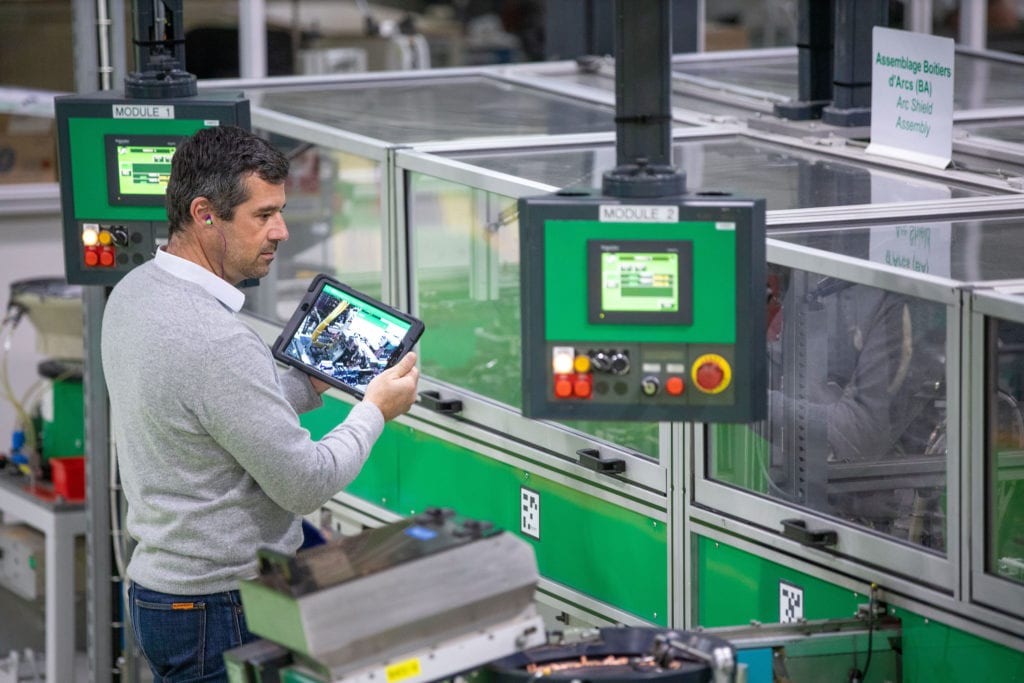Most people believe manufacturing is highly automated, and they are right! Robots are heavily used in process automation to make everything from cookies and computers to convertibles. However, the world is a competitive place and companies must increase their manufacturing capacity and customization capability while driving down costs. As Olympic gold medal wrestler Cael Sanderson puts it, “Unless you continually work, evolve, and innovate, you’ll learn a quick and painful lesson from someone who has.”
That’s why many companies will add a significant number of IoT devices and IT capacity (cloud with edge computing) to bring in Industry 4.0 technologies including artificial intelligence (AI), video analytics, augmented and virtual reality (AR/VR), additive manufacturing (custom), and advanced Robotic Process Automation (RPA). I know it’s a cliché, but it really is the merging of IT (Information Technology) and OT (Operational Technology).
Connecting devices is the foundation of Industry 4.0
Connecting IoT sensors, meters, and high definition video cameras is the foundation of Industry 4.0. Devices gather information from wherever they’re placed and, without them, nothing else will work. As more endpoints become connected, transmitting and coordinating the massive volumes of data in real time is a monumental challenge. Companies will need to have robust solutions that can successfully handle variable workloads from a multitude of IoT devices in a scalable and reliable manner. Most factory operators are used to physical ethernet wiring and interconnect systems designed for smart factories, which can support data transport speeds up to 1Gb/s (CAT5e) and 10Gb/s (CAT6A). This capacity is important when high-definition video is transported, or machines and control systems are operating in real time.
Connecting devices and factory systems using physical communication cables has always been the fastest and most reliable approach, until now with the release of mmWave 5G (high band 5G). 5G will deliver the ability to communicate at rates comparable to ethernet without the cable, promising eventual download rates of 20 Gbps and — just as importantly — upload rates of 10 Gbps. 5G will also virtually eliminate the problem of latency. Latency is not to be confused with speed or bandwidth; it describes the delay when sending information from one place to another. Latency is measured in milliseconds (ms), and 5G networks using URLLC (Ultra-Reliable and Low Latency Communications) can theoretically reduce latency to a single millisecond. The advantage is keeping all machines and robots perfectly in sync in real time. The specification for 5G networks allows up to one million devices per square kilometer, which is a massive number that will accommodate Industry 4.0 machine-to-machine (M2M) communications. So, 5G will deliver capacity, speed, and near zero latency with the additional advantage of not being tethered to any kind of hard communication line. Note that mmWave 5G is mainly in a “trials” phase now, but I believe it will be the communications technology of choice going forward.
The need to process data close to its source
Those large amounts of IoT devices will increasingly rely on 5G to connect time sensitive process to the IT infrastructure, but where do the IT systems reside? IoT by definition implies they are connected to the internet, but does it make sense for Industry 4.0 technologies to communicate to a hyperscale cloud data center that is hundreds or thousands of miles or kilometers away? For some technologies yes, while for others, not so much. Industry 4.0 is a fairly complicated realm involving a series of technologies coming together to build one aggregate system. This system includes the data center architecture, which will need to be hybrid with on-premise (edge) as well as off-premise (central or core). 5G will bring super-fast, latency-free wireless connections, but only in the local manufacturing environment. The transmission path to a centralized cloud data center involves distance and network “hops” that will cause significant delays. For truly latency-free processes, factories will need edge computing on-site. This enables processing of the data close to its source rather than in the centralized data center.
The real-time controls of video analytics, augmented reality, and autonomous robotics are the main technologies that will drive computing capacity to the local edge. The local edge will be a vital intermediary between the endpoints and core IT infrastructures. Edge data centers will need to be placed in close proximity or actually embedded into the manufacturing environment for the best results. For example, high bandwidth video use will increase in quality control applications. Real-time IVA (Integrated Video Analytics) with a single high definition camera generates about 300GB of data per hour that needs to be processed in real time — and many systems utilize multiple cameras. The best solution for this would be a dedicated micro data center to protect the servers from dust, water, heat, and power disturbances.
With 5G, machines will talk to each other
5G will also enable machines to talk to each other and share information. This opens the door to more advanced visualizations and simulations based on real-time data. Decisions and actions from the digital world will translate into movements in the physical world. For example, manufacturing machines could analyze production efficiencies based on the availability of the raw materials, the performance and availability of robots, and the energy costs, then decide what to build and when to build it.
Data analytics on manufacturing equipment wear or digital twin modeling are examples of non-time critical technologies that can be efficiently handled by the centralized cloud.

Schneider Electric has partnered with telco operator Orange at its Le Vaudreuil factory in France to run 5G industrial trials. The project will facilitate the convergence of Information and Operational Technologies (IT/OT) for a comprehensive co-innovation approach. The indoor 5G-enabled trials will support two use cases: augmented reality applied to maintenance technician activities and the implementation of a telepresence robot for remote visits. More trials will be developed to test technologies with strong potential such as artificial intelligence and virtual reality. Since 5G is a software defined application, there will be software updates that can expose more and more potential.
Industry 4.0 is a major step in digital transformation that brings together the worlds of IT and OT. Automation of industrial processes will be heavily dependent on high capacity, high speed, low latency, and reliable 5G and edge computing for the reliable delivery of Industry 4.0 technologies. I encourage you to read the white paper Industry 4.0: Minimizing Downtime Risk with Resilient Edge Computing as it will help you in your journey to reliably deploy edge computing into Industry 4.0.



